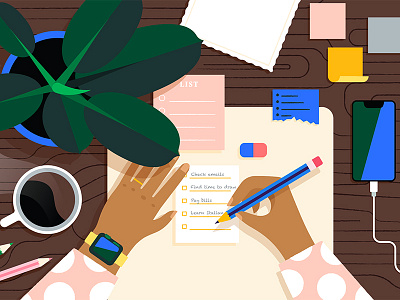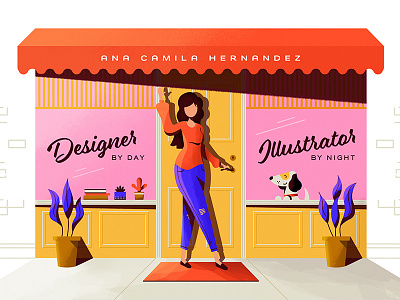In this sponsored blog post written by our friends at Domain.ME, learn the most essential elements to include in your personal website as a freelance creative, plus how to maximize your portfolio so you get hired ■
Row 1: Frederique Matti, Gyöngyi Balogh for Creatopy, Morgane Sanglier .
We’re all well aware that a personal website is a tool of the trade for any freelancer. This holds true regardless of where you find client work. Point is, people will turn to the internet to find out who you are and what your work is about. What better way to shed light on both matters than having your website come up as one of the first search results on Google (or any other search engine)?
It’s true that building your personal website can surface some doubts and confusion around where to even begin—what elements should I include; how many pages do I really need; should I use a website builder or customize a WordPress theme? The list goes on and on.
To put your mind at ease, we’ve compiled the ultimate checklist for building your personal website as a freelancer. Let’s jump straight into it!
Must-have elements of a personal website
There are four essential elements to every personal website. One does not go without the other, and together they can hook any client you desire. That’s precisely why these four elements need to be carefully planned and well-executed, should you wish to reap the maximum benefits. These elements are the about page, portfolio page, contact information, and a call to action that packs an extra punch.
✔️ About Me Page
You might be inclined to think that your About page should contain information pertaining to your name, followed by a short description of your past endeavors, and finished with a cool/funny/obscure photo of yourself. Well, you’re not wrong per se, but there is so much more to the About page than that.
The About page is your chance to let prospective clients meet the designer behind the work. This is your opportunity to introduce yourself, show your credentials, to say what inspires you, what type of work you are interested in, and showing what sets you apart from the competition.
Don’t: Include your life story. Unless a certain event or part of your life has influenced your work profoundly, steer clear of mentioning your first art projects in school, unless it explains your why (remember Daniel Pink—Start with why?).
✔️ Portfolio Page
Needless to say, your portfolio page is your place to shine. Whether you label it ‘work’ or ‘portfolio’ or something entirely different, this page must introduce your work in the best possible light. Depending on what the focus of your work is, the way you present your portfolio might differ—just make sure you handpick the projects that convey to your prospective clients that you are indeed expert at what you do!
This might sound familiar to you: more often than not, we fall into a trap of wanting to perfectly present and describe each project to the tiniest of details. Don’t postpone publishing your website because you haven’t managed to make each project perfect. Start small by focusing on the most essential projects, and then add more as you go.
Don’t: Put everything you ever worked on your website. A portfolio page is a place where only your best and most relevant work should exist.
✔️ Contact information
While this is one of the most obvious elements of a personal website, it’s also one of the most underrated ones. Your contact information should be clearly presented and it must be easy to find. Sure, you might think that if someone wants to contact you, they’ll find a way. This is true, but also not the point. Your goal should be to look professional and ready to collaborate, so be mindful of that when you think about where you should place your contact info.
Don’t: Forget to double-check that your contact form works. It also might be wise not to display your email address in order to avoid all of the spam mail. Instead, you can opt for a contact form. If you do, make a test run to be sure it works!
✔️ A Clever Call To Action
Think of the call to action as your elevator pitch. Although it’s a much shorter pitch than what you could muster in real life, a call to action is your hook to landing the client. Imagine this—they’ve looked around your personal website, liked what they’ve seen and read, and all they need is that clever sentence that helps them definitely decide they want to hire you!
Don’t: Focus on the wrong person when creating your call to action. Always try to position yourself in the client’s shoes when coming up with a good call to action line.
What you should also consider including
While the elements mentioned above are indeed must-haves when it comes to a personal website, focusing solely on them will leave your website incomplete. In order to paint the full picture, consider including your brand as a part of the website, social media links, articles you’ve written, link to your blog, and testimonials that will speak to your credibility.
✔️ Your Logo
Your logo should be well thought out and clearly visible on your website. Think of it as your identity badge—it represents you as a designer. Besides a logo, think carefully about the fonts and colors you choose, UX solutions you present, and so on. Make sure you personalize your website and brand it, so it speaks of who you are and what you can do.
✔️ Other online presences
Nowadays, it’s important to be prominent in the world of social media. However, when it comes to your personal website that introduces you to the world as a freelance designer, it’s wise to think twice before linking your personal Facebook page or TikTok account which have no connection to your work. Also, consider linking any articles you’ve written that focus on design!
✔️ Your professional blog
We can already hear your exclamations reminding us that you are designers and not writers. Yes, we know. But, did you know that having a blog as a part of your website can increase your number of visitors (SEO, anyone?)? And if you are writing on topics relevant to the part of the design industry you want to focus on (we recommend that you do so), you just might establish yourself as a leader in your design niche.
✔️ Testimonials that will seal the deal
We can all agree that recommendations are extremely important. They serve as evidence that you are a professional who is able to fulfill your tasks, deliver the agreed-upon work, and communicate professionally. Most importantly (and by nature), they recommend you to those who are considering whether to hire you or not.
In essence, testimonials are more or less like those product reviews we read before deciding on whether we’ll buy a product or not. When you get a chance, collect those testimonials!
Pro tip: It’s best to ask for a testimonial after the project is finished. And make sure to do it even if you don’t plan on using it right away!
✔️ Bonus: A Personal Domain Name
Choosing a domain name for your website is an important decision you’ll have to make. We might not be impartial, but selecting a personalized domain name that speaks to who you are is something you should pay attention to. We’d opt for .ME, since it is highly personalized and can make your domain name different and unique!
Back to you
Whether you’re building a personal website from scratch or updating the one you already have, keep in mind that a strong online presence will not only set you apart from the competition, but also help you establish yourself in the part of the industry you want to focus on. Go through our checklist, revise your decisions, and above all, keep it personal!

About the author: Natasa Djukanovic is the CMO of Domain.ME, the international tech company that operates the internet domain “.ME.” She has spent her entire career at the intersection of social media, leadership, and technology, and is constantly trying to figure out the secret to being in three different places at the same time.
Looking for work? Browse freelance graphic design jobs on Dribbble. ■
RELATED READING
- How to make your personal brand stand out online
- 4 personal website ideas for designers and why they work
- How to boost your online presence as a designer in 3 simple steps
Find more Process stories on our blog Courtside. Have a suggestion? Contact stories@dribbble.com.














